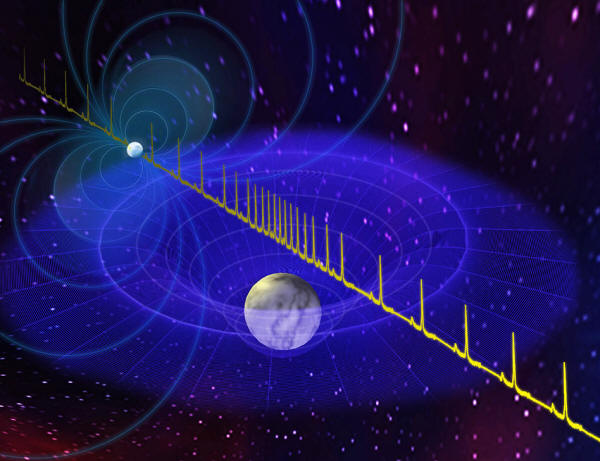|

September 16,
2019
from
NationalRadioAstronomyObservatory
Website

Credit: BSaxton
NRAO/AUI/NSF
Astronomers using the
Green Bank
Telescope
have discovered
the most massive
neutron star to date,
a rapidly
spinning pulsar
approximately
4,600 light-years from Earth.
This
record-breaking object
is teetering on
the edge of existence,
approaching the
theoretical
maximum mass
possible
for a neutron
star.
Neutron stars - the compressed
remains of massive stars gone supernova - are the densest "normal"
objects in the known universe. (Black
holes are technically denser, but far from normal.)
Just,
a single sugar-cube
worth of neutron-star material would weigh 100 million tons
here on Earth, or about the same as the entire human population.
Though astronomers and
physicists have studied and marveled at these objects for decades,
many mysteries remain about the nature of their interiors:
Do crushed neutrons
become "superfluid" and flow freely?
Do they breakdown
into a soup of subatomic quarks or other exotic particles?
What is the tipping
point when gravity wins out over matter and forms a black hole?
A team of astronomers
using the National Science Foundation’s (NSF) Green Bank
Telescope (GBT)
has brought us closer to finding the answers.
The researchers, members of the
NANOGrav Physics Frontiers Center,
discovered that a rapidly rotating millisecond pulsar, called
J0740+6620, is the most massive
neutron star ever measured, packing 2.17 times the mass of our Sun
into a sphere only 30 kilometers across...
This measurement
approaches the limits of how massive and compact a single object can
become without crushing itself down into a black hole.
Recent work involving
gravitational waves observed from colliding neutron stars by
LIGO suggests that 2.17 solar
masses might be very near that limit.
"Neutron stars are as
mysterious as they are fascinating," said Thankful Cromartie, a
graduate student at the University of Virginia and Grote Reber
doctoral fellow at the National Radio Astronomy Observatory in
Charlottesville, Virginia.
"These city-sized
objects are essentially
ginormous atomic nuclei. They
are so massive that their interiors take on weird properties.
Finding the maximum
mass that physics and nature will allow can teach us a great
deal about this otherwise inaccessible realm in astrophysics."
Pulsars get their name
because of the twin beams of radio waves they emit from their
magnetic poles.
These beams sweep
across space in a lighthouse-like fashion.
Some rotate hundreds
of times each second.
Since pulsars spin
with such phenomenal speed and regularity, astronomers can use
them as the cosmic equivalent of atomic clocks.
Such precise
timekeeping helps astronomers study the nature of spacetime,
measure the masses of stellar objects, and improve their
understanding of general relativity.
In the case of this
binary system, which is nearly edge-on in relation to Earth, this
cosmic precision provided a pathway for astronomers to calculate the
mass of the two stars.
As the ticking pulsar passes behind its
white dwarf companion, there is a
subtle (on the order of 10 millionths of a second) delay in the
arrival time of the signals.
This phenomenon is known
as "Shapiro
Delay."
In essence, gravity from
the white dwarf star slightly warps the space surrounding it, in
accordance with Einstein’s general theory of relativity.
This warping means the
pulses from the rotating neutron star have to travel just a little
bit farther as they wend their way around the distortions of
spacetime caused by the white dwarf.

Astronomers have detected what could be
the most massive Neutron Star
(Pitris/iStock)
Astronomers can use the amount of that delay to calculate the mass
of the white dwarf.
Once the mass of one of
the co-orbiting bodies is known, it is a relatively straightforward
process to accurately determine the mass of the other.
Thankful Cromartie is the principal author on a paper (Relativistic
Shapiro delay measurements of an Extremely Massive Millisecond
Pulsar) accepted for publication in Nature Astronomy.
The GBT observations were
research related to her doctoral thesis, which proposed observing
this system at two special points in their mutual orbits to
accurately calculate the mass of the neutron star.
"The orientation of
this binary star system created a fantastic cosmic laboratory,"
said Scott Ransom, an astronomer at
NRAO and coauthor on the paper.
"Neutron stars have
this tipping point where their interior densities get so extreme
that the force of gravity overwhelms even the ability of
neutrons to resist further collapse.
Each 'most massive'
neutron star we find brings us closer to identifying that
tipping point and helping us to understand the physics of matter
at these mindboggling densities."
These observation were
also part of a larger observing campaign known as
NANOGrav, short for the North
American Nanohertz Observatory for Gravitational Waves, which is
a Physics Frontiers Center funded by
the NSF.
The National Radio
Astronomy Observatory is a facility of the National Science
Foundation, operated under cooperative agreement by
Associated Universities, Inc.
The Green Bank Observatory is a facility of the National Science
Foundation, operated under cooperative agreement by Associated
Universities, Inc.
|



